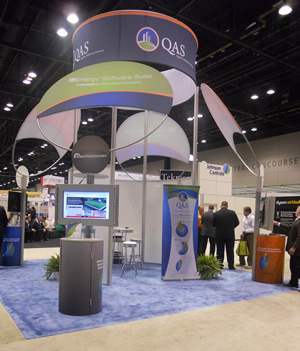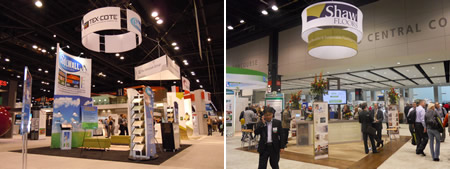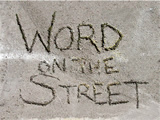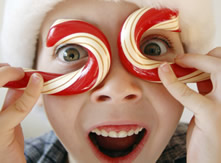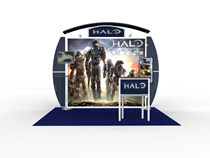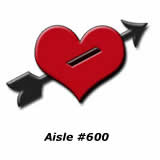
Love on Aisle #600 -- Trade Shows and Events
Shame. Shame, Shame. Get your mind out of the gutter. This is neither a steamy romance nor an even steamier fantasy. This is about the love of trade shows and why you, me, or anyone else attends them.
Over the years, I’ve read more articles than I’d care to admit about why trade shows are important, why exhibit marketing is effective, and why we MUST attend them. They make sense, in the same way that taking vitamins makes sense. On some level you know it can’t hurt and it’s good for you, even if you can’t always measure the results. I could give you the typical sales and marketing reasons to attend, but I won’t. Instead, I’ll share nine reasons why I attend trade shows. It may not be as informative, but it will be a lot more interesting.
Reason #1: I have to. I work for a trade show exhibit designer and manufacturer. Even worse, I co-manage the business so I can’t even pretend to hate trade shows, even if I did. Which I don’t. (Just in case my boss reads this, let me repeat, “I enjoy attending trade shows!”)
Reason #2: I get to see family, friends, and acquaintances. That’s a big deal to me. Until about two years ago, my brother lived in Las Vegas. Attending a trade show in Vegas was an excuse to see my brother. When TS2 was in Philadelphia, I had dinner with my old college roommate. Mostly, I get to see colleagues and industry suppliers whom I’ve known for years. Since I don’t travel quite as much as I used to, the shows are an excuse to chat about business and politics, to have a drink or two, and to gossip, learn, and enjoy.
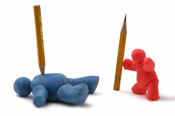
Red vs. Blue
Reason #3: Competitors. They are there, just like you, with the latest and greatest. Even if you don’t get to see all the whiz-bang cool stuff, you get a sense of what direction they are headed. Are they moving upstream? Downstream? Are they investing in R&D? Who’s hanging out in their booth this year? Who’s not? I never understand why companies forbid their employees from chatting with competitors. Obviously, you have to be smart about what you do or do not share, but from my experience, most competitors are friendly, and the stories, observations, and lies you share are at worse harmless and at best enlightening. And to those not so friendly competitors . . . your paranoia will shorten your life by about 10 years.
Reason #4: I love walking the show floor because there are so many folks with encyclopedic knowledge about an industry. I attended my first trade show in 1994, about a month after starting as the marketing director for an exhibit manufacturer. The owner, a man who knew everyone at the show, introduced me to what seemed like hundreds of people. As we walked the show, he shared his knowledge about the industry, the history of the various companies, and the benefits and features of the products. What I learned by walking the show, both on my own and with him, compressed my learning curve by a good year. I could have never gotten the same information without attending the show.
Reason #5: Ink pens. My wife is a writer. She loves pens, all kinds of pens, but mostly fat pens. I score major points whenever I bring home 3-4 cheap trade show pens, especially if they have some kind of gimmick (and are fat).
Reason #6: Trade shows are an amazing buffet of new ideas. How can you not be impressed by the collective creativity? Whether it’s EuroShop in Germany or the local Business-to-Business show by the Chamber, I always discover new products, services, presentations, trinkets, and people. Even if I’m not looking for something specific, I usually find something worth pursuing after the show that will benefit our business or our customers. Would a virtual trade show offer the same experience? Perhaps, but I doubt it.
Reason #7: Customers. Trade shows are a lot like annual employee performance reviews. There should be no surprises, unless they’re positive. If you dread attending your annual industry trade show because of customer complaints, then your company is in serious trouble. I attend for just the opposite reason. Like Reason #2, I really enjoy meeting customers, talking about their businesses, learning about the challenges in their markets, and hearing about their lives. I know it’s a cliché, but shaking someone’s hand and looking them in the eye changes everything. Sure there may be a negative here and there, but it’s mostly all positive. Over the years, I can only count a few times, working with various companies, that I haven’t left a show feeling upbeat.
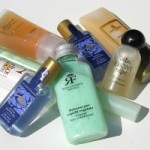
What? No Sewing Kit!
Reason #8: Hotel/Motel Toiletries. Actually, I don’t really care about the shampoo or the conditioner, but I hoard the little soaps. I am cheap, but that’s not the reason. I can’t stand the liquid soap at the gym where I am a member, and over the years I’ve probably left over a 100 bars of soap at the gym because I’m absent-minded. The mini-motel soaps are perfect. I don’t care if I leave them, and I don’t care about the brand.
Reason #9: Potential Customers. Next to chatting with existing customers, potential customers are my favorite reason to participate in trade shows. You get to see your company and your booth through their eyes. Is your product and service relevant to them? What interests them? What have they seen at the show that appeals to them? What does the future hold for them? For you? Far too many exhibitors are simply carnival barkers with more teeth and less visible tattoos. They want to close the sale, not create a relationship. That’s unfortunate because no one wants to be assaulted at a show. “Listen and Learn” is my mantra at every show.
Reason #10: For purely selfish reasons, I need a #10 to complete the list. Please take a moment and share your reason for attending/participating in trade shows. Why do you love to stroll down Aisle #600?
— Mel White
Additional Blog Entries:
10 Quick Tips for Any Trade Show Novice
Trade Shows as First Dates




